Short Guide to Visiting the Church of Leus Near Permet, Albania
8 min readA quick guide to visiting the spectacular Orthodox Church of Leus outside Permet.
I am not a particularly spiritual person, but there are certain religious buildings that stir something up and stay with me for years. The Painted Mosque in Tetovo is a good example.
Albania is majority Muslim, yet it is home to some of the most spectacular Orthodox churches I have ever visited. From the gorgeous post-Byzantine temples in Voskopoja and Korca, to the tumbledown chapels in Berat, and the Greek-style churches in Dhermi and along the riviera, I have been lucky enough to see more than my fair share.
None of them come close to the 18th-century Church of Leus. There is something special about this basilica that is difficult to describe. Maybe it’s the remote location, or simply the vividness of the icons. The exhausting hike up the hill certainly contributes to a feeling of accomplishment.
If you have been to Leus, then you will know what I am talking about. And if you are thinking of going, let this be your sign to make the effort.
For this short guide, I wanted to recount my personal experience of visiting the church. You can find practical tips for planning your own trip to Leus at the end.
Please note: This post contains affiliate links, meaning I may earn a commission if you make a purchase by clicking a link (at no extra cost to you). Learn more.
Briefly about Leus
Tucked away on the forested slopes of Mount Dhëmbel in southeastern Albania, Leus (Leusë) is a tiny village of less than 100 people. It takes its name from the Greek word Eleusa or ‘merciful’, which is associated with the Virgin Mary in the Eastern Orthodox tradition.
It is located within walking distance of Permet, Albania’s emerging ecotourism and Slow Food capital. Most people visit from there, either hiking up to the village (as described below) or hitching a ride in a 4×4.
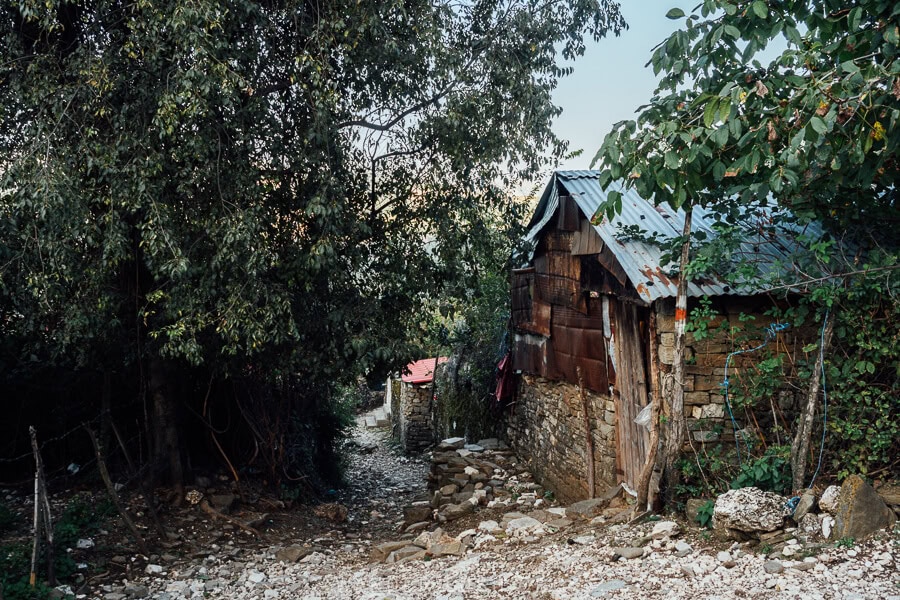
At the end of the 19th century, most of Leus’s residents were Aromanian families. The village was decimated during WWII (thankfully, their church was somehow spared) and during the communist period, agricultural workers were relocated here. Many of them still practise transhumance, travelling down to the lowlands during winter with their livestock.
Majority of the population adheres to Eastern Orthodoxy, celebrating the Feast of the Dormition of Mary every August with a lively street folk festival.
Our visit to St. Mary’s Church
We arrived in Permet on a misty October afternoon and decided to make a beeline for Leus. We set off through the outskirts of the city and found the start of the rough village road. Glad to have left our little hire car behind at our hotel, we steeled ourselves for the steep, uneven climb to the top.
Nothing good comes easy, and the 45-minute walk up to Leus is certainly a challenge. On the plus side, the incline is fairly gradual, and after every steep turn a beautiful new panorama of the city below unveils itself as a reward for your hard work.
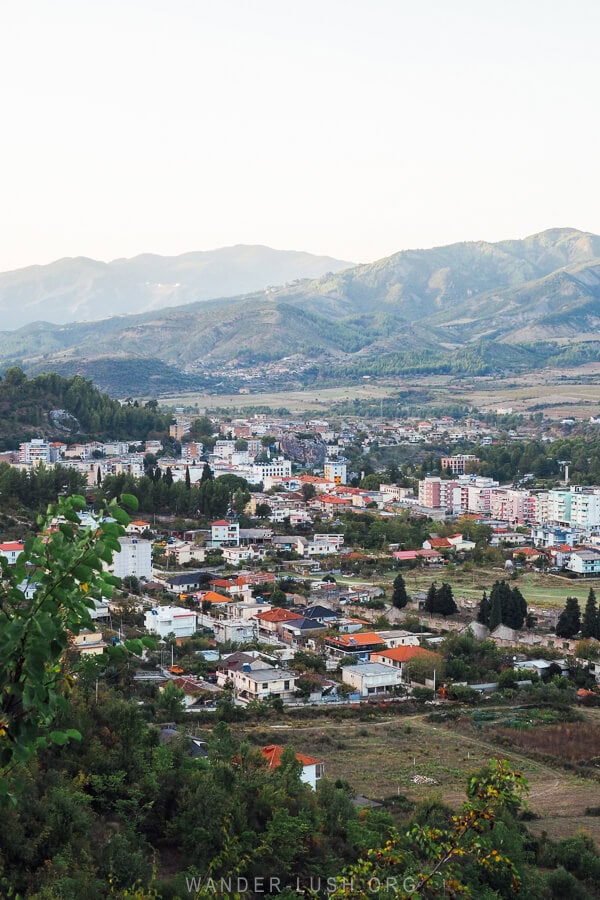
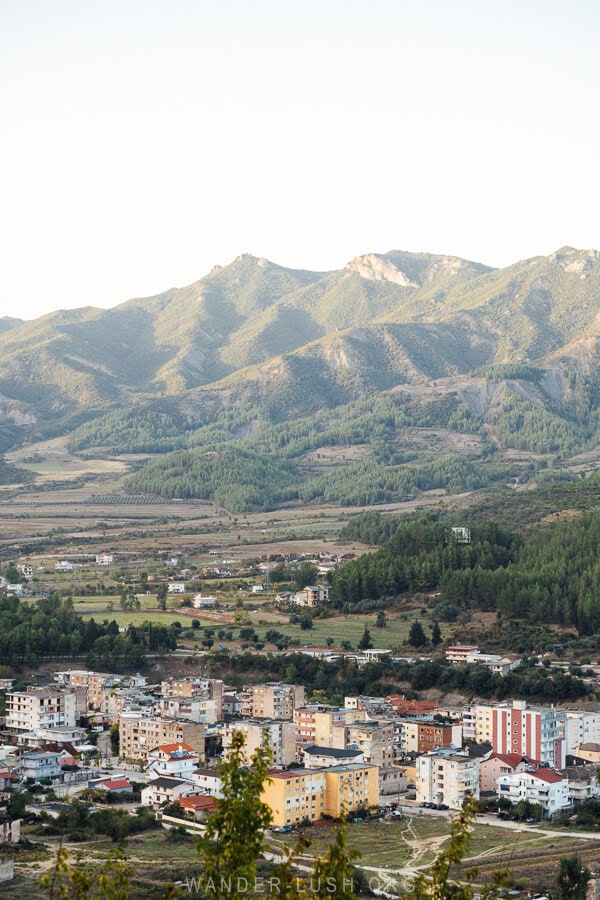
As we pushed up the path, a 4WD approached us from behind. The driver wound down his window and apologised for not having room for us – he was carrying a full load. We smiled and waved and said ‘no worries’. It was only later that I realised he was the owner of Chri Chri, the only guesthouse in Leus. I had been communicating with him earlier that day after we rearranged our plans to stay an extra night in Permet (that’s how good of a first impression it made). My desperate attempts to try and get a room at the last minute sadly didn’t pan out.
As we neared the village, we looked out through the trees and got our first glimpse of St. Mary’s. The long, two-storey pumice stone building with a slate-coloured roof looks magical from afar, as if it’s floating in the forest.
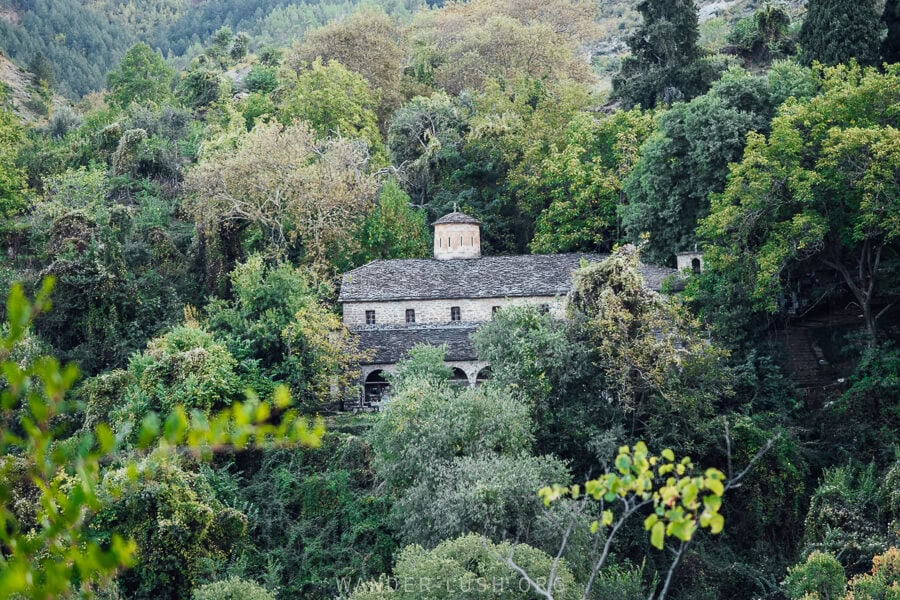
We entered Leus and walked down the stone steps into the sunken yard.
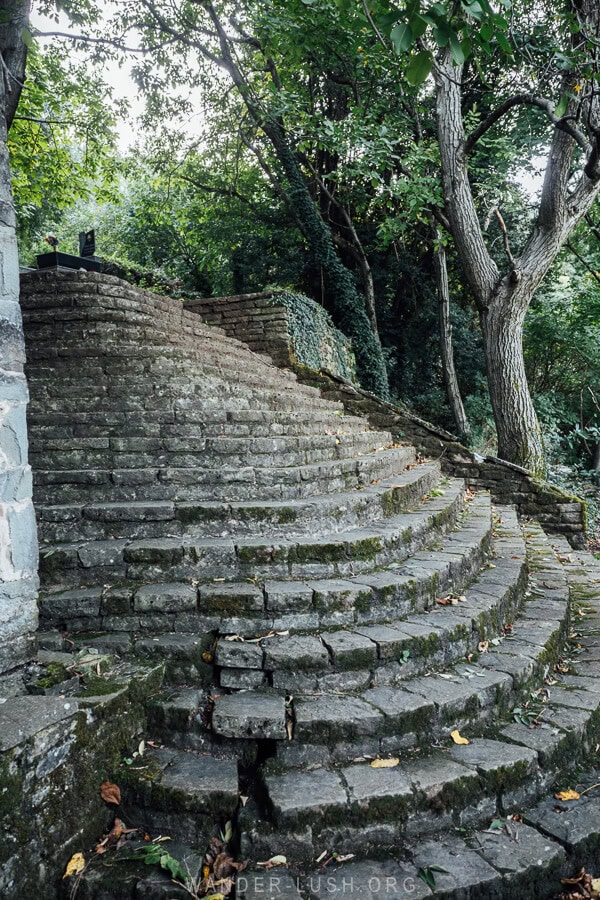
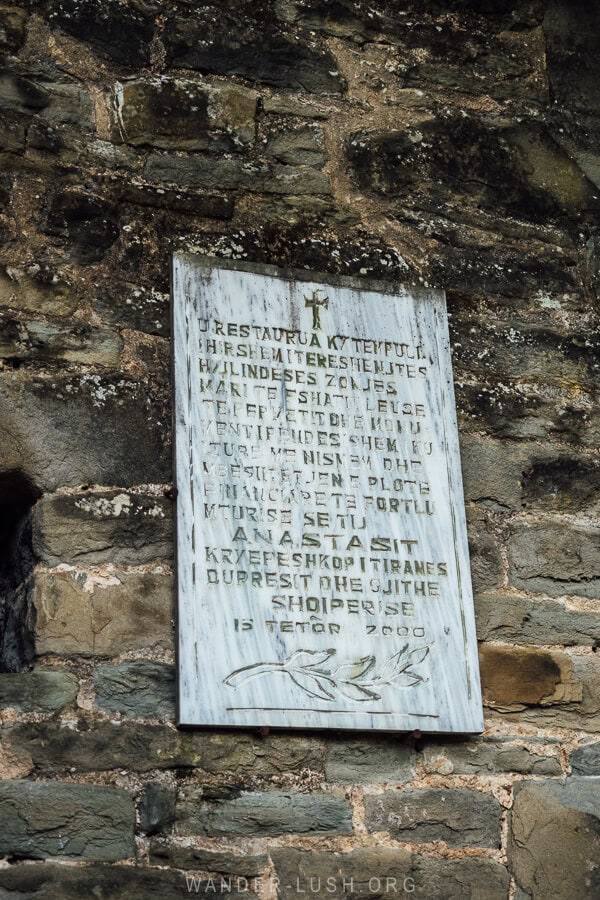
Typical of Albanian churches, one side of the building has a long porch with a row of stone arches. We walked inside and started studying the paintings, a mix of scenes depicting saints and kings riding on the backs of lions. These exterior paintings are quite faded and very badly damaged, defaced with scratch marks and graffiti.
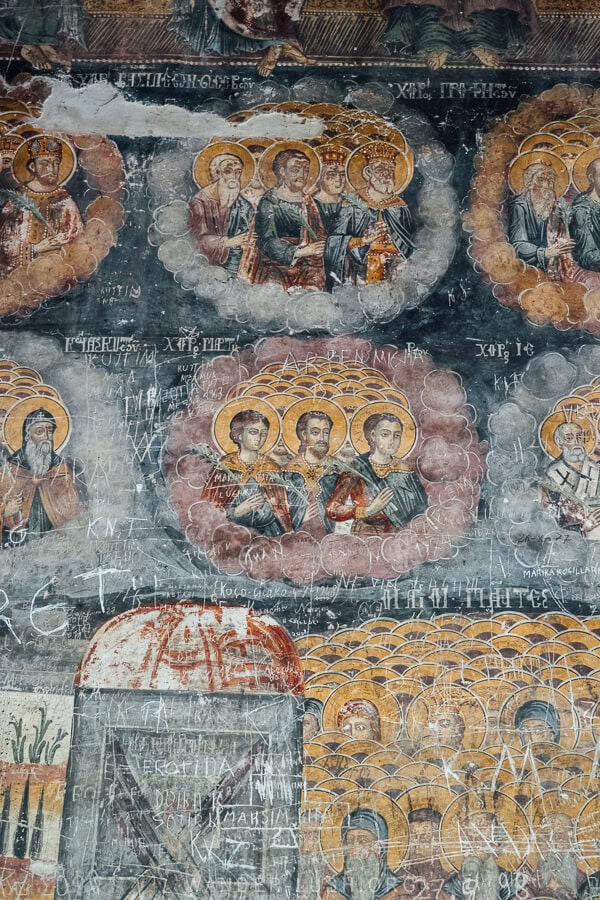
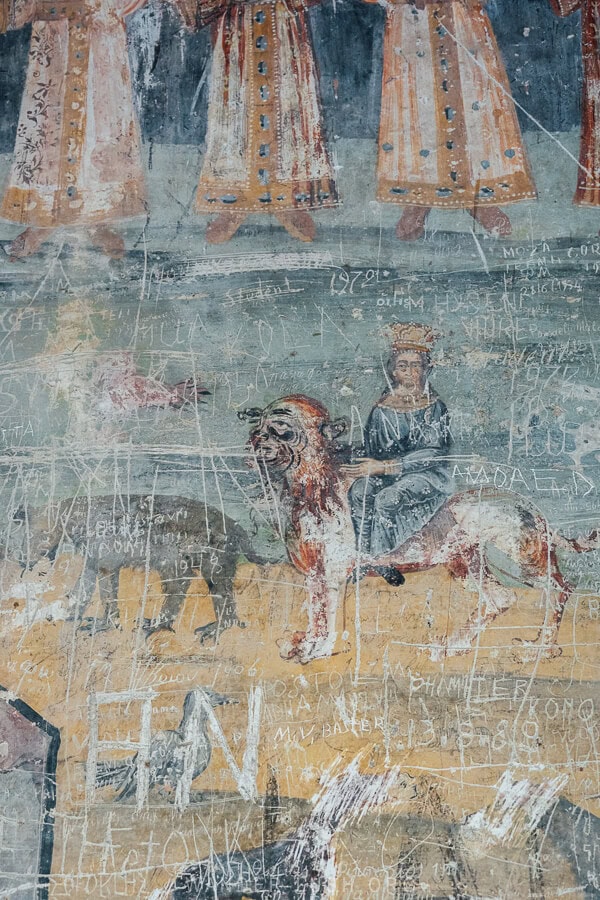
Naturally I tested the heavy wooden door, but it didn’t give an inch. So I took my time absorbing the paintings, thinking this might be the furthest we would get.
I had read online that it was possible to ask around in the village for the key. But I am way too sheepish for such things. So I sent Ross off to scope it out instead.
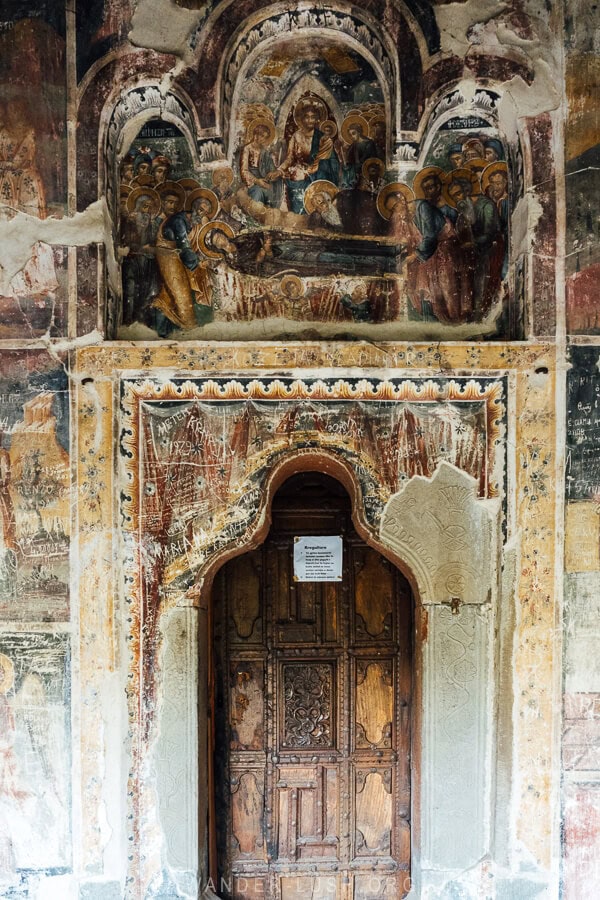
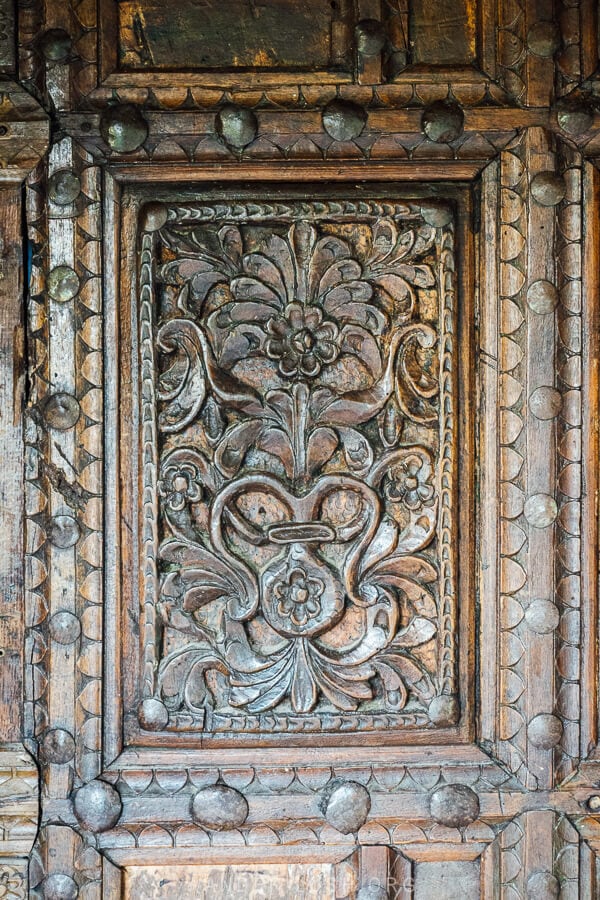
While he was gone, I picked a path through the overgrown cemetery next to the church and admired the headstones. More tourists – first a group of travellers from China, then a woman from Poland – trickled down the stairs.
Ross returned wearing a big grin: A group tour had just arrived, and their guide was currently collecting the key.
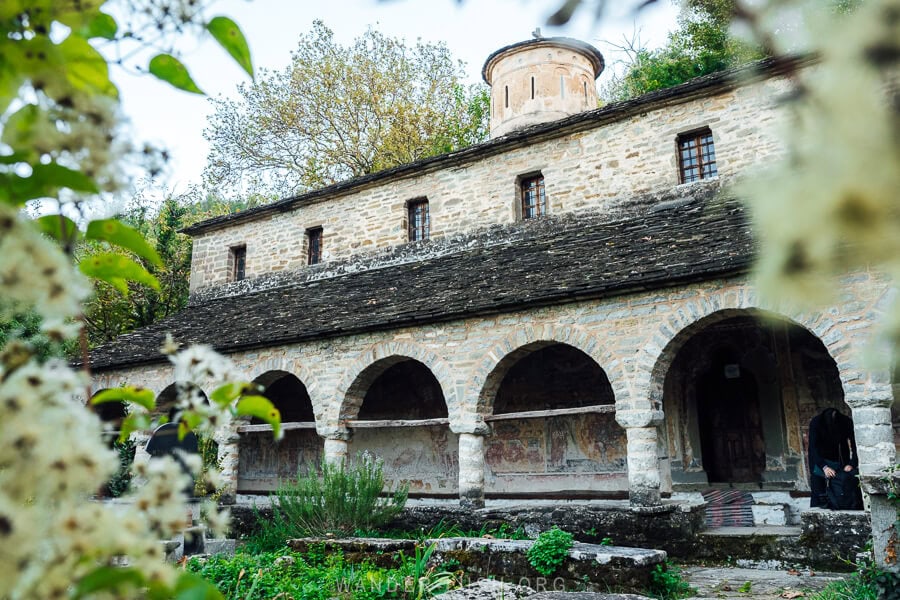
The next part is a blur. Before we knew it, the driver of the 4WD who passed us earlier had flung open the door, and we were being ushered inside along with the eager tour group.
Stepping into the narthex, I was so overwhelmed I almost lost my balance. I didn’t know where to look: Every flat surface from the ceiling to the arcades and the columns was plastered with some of the most vivid frescoes I have ever seen.
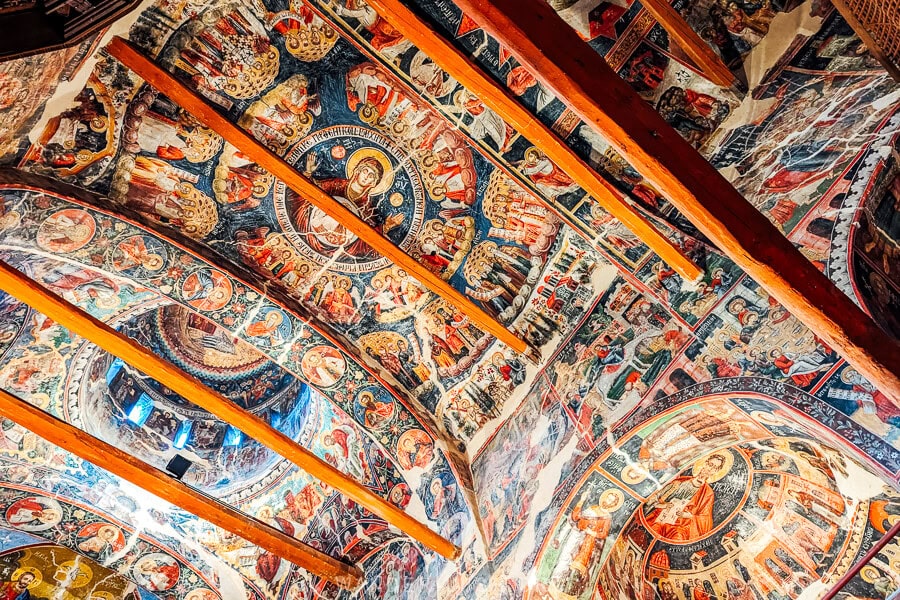
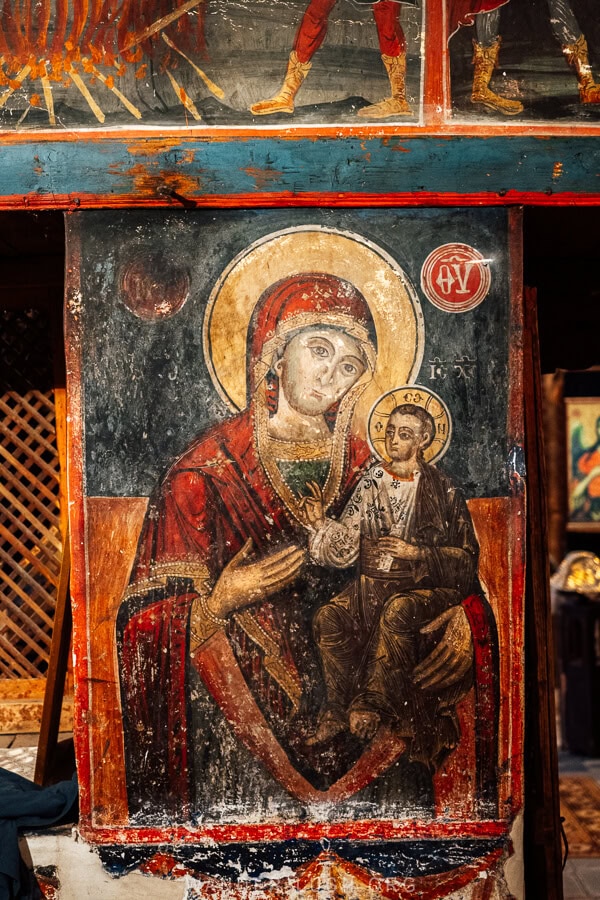
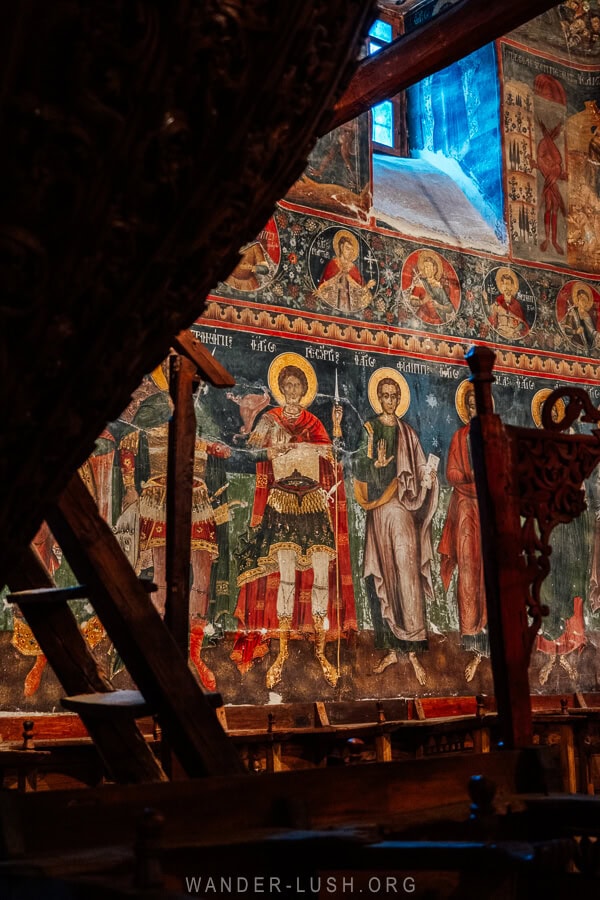
Incredible details are rendered in a palette of royal blues and deep reds. The colours of the icon paintings are as rich as the day they were painted. My photos don’t begin to do it justice. It’s impossible to capture the scale of the decorations or the atmosphere of the place. It is truly magnificent.
Along one side of the nave, a row of carved pews appeared. And in the distance, concealing the sanctuary, a magnificent iconostasis crafted from wood.
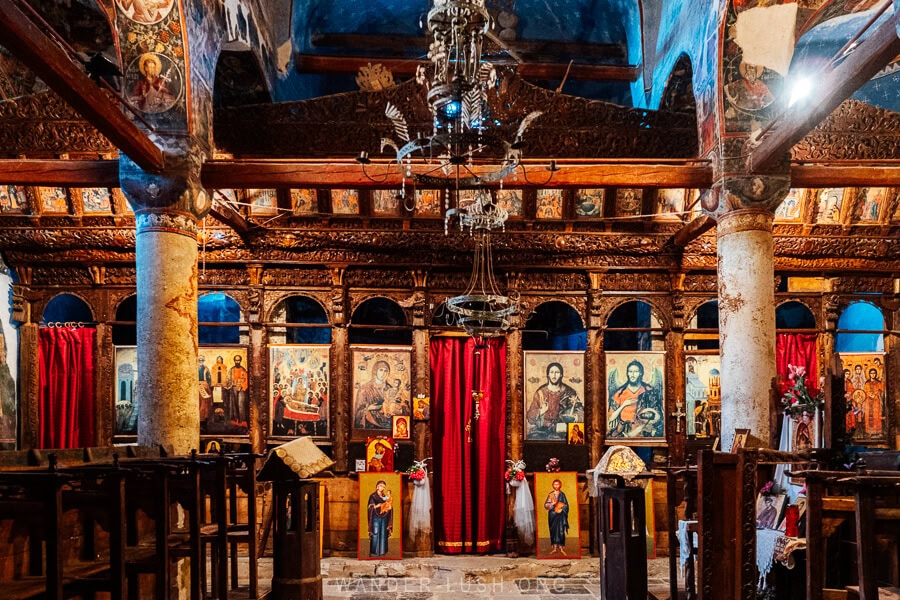
The tour group had been very chirpy indeed whilst waiting outside. Once we were in, everyone fell silent. This church inspires a kind of dumbfound reverence. With all those saintly gazes fixed on us, it seemed improper to talk or even whisper.
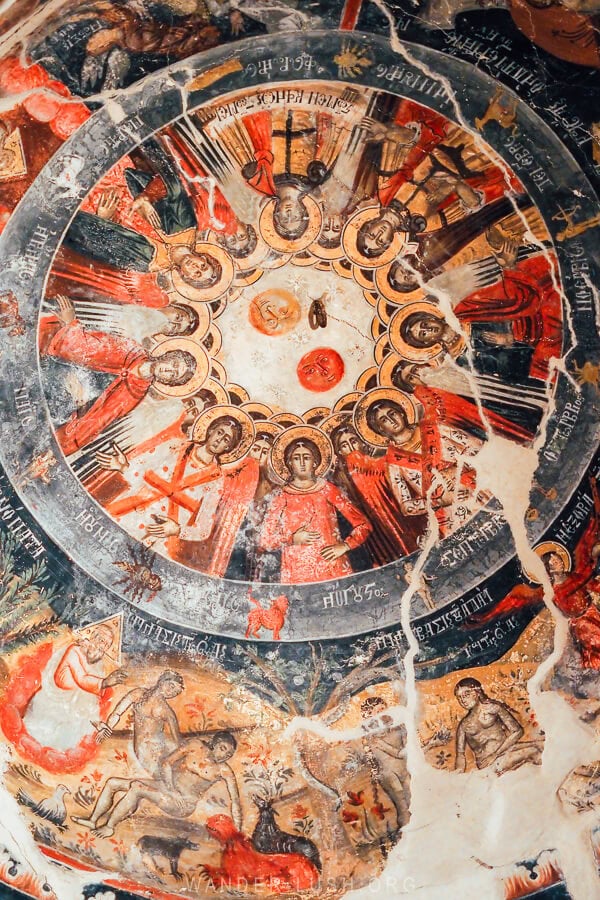
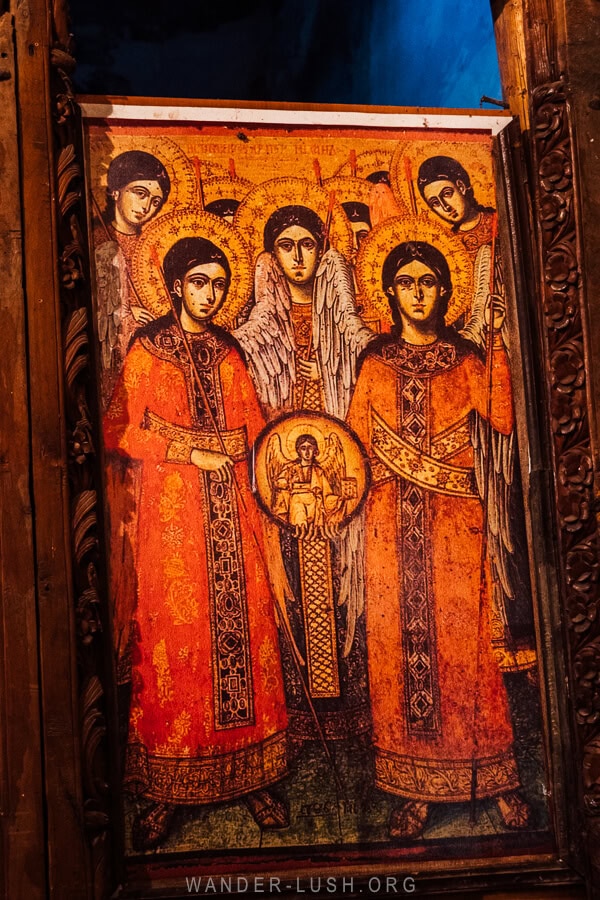
At one point I turned around and wondered where everyone else had gone. Then I realised there was a set of stairs.
I don’t think I have ever been inside an Orthodox church where entry to the second level is permitted. Gleefully I raced up to the open mezzanine – being careful not to knock my head on one of the wooden beams – and looked out at the frescoes from an elevated position, almost from the same level as the dome. Wow.
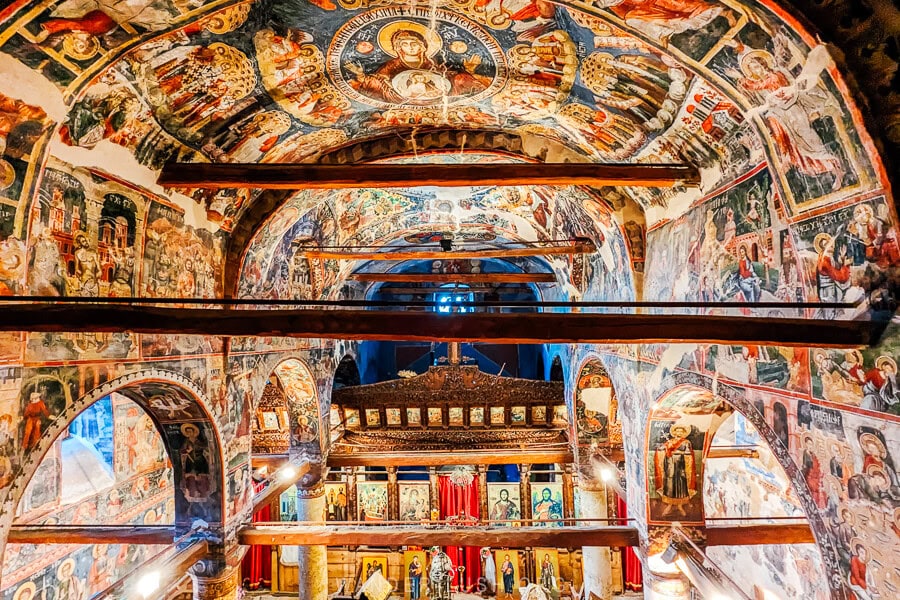
On the way back down, I noticed the wood ceiling carved with a thousand mosaic-like coloured sections and an image of Jesus at the centre. It looked just like the inlay ceilings you see in old Ottoman-style mansions.
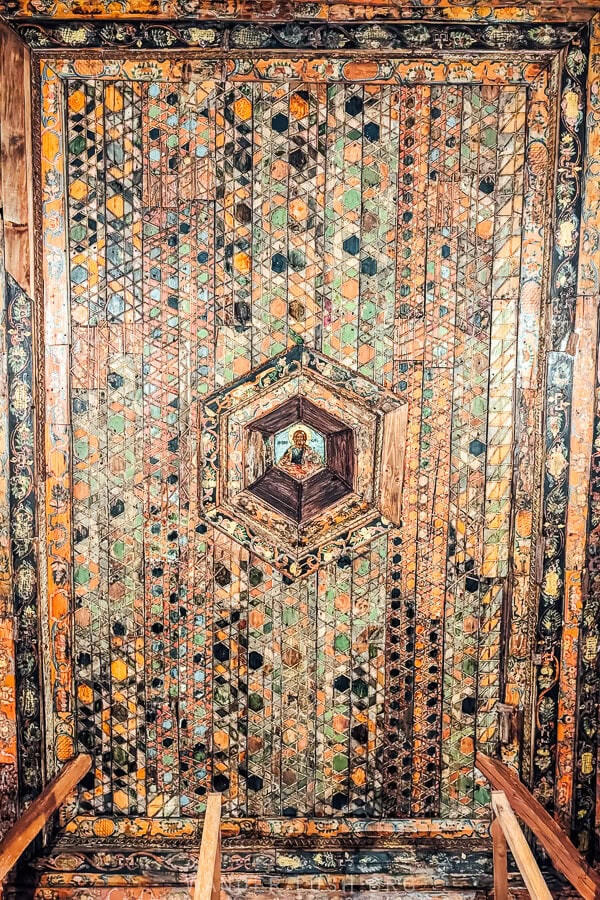
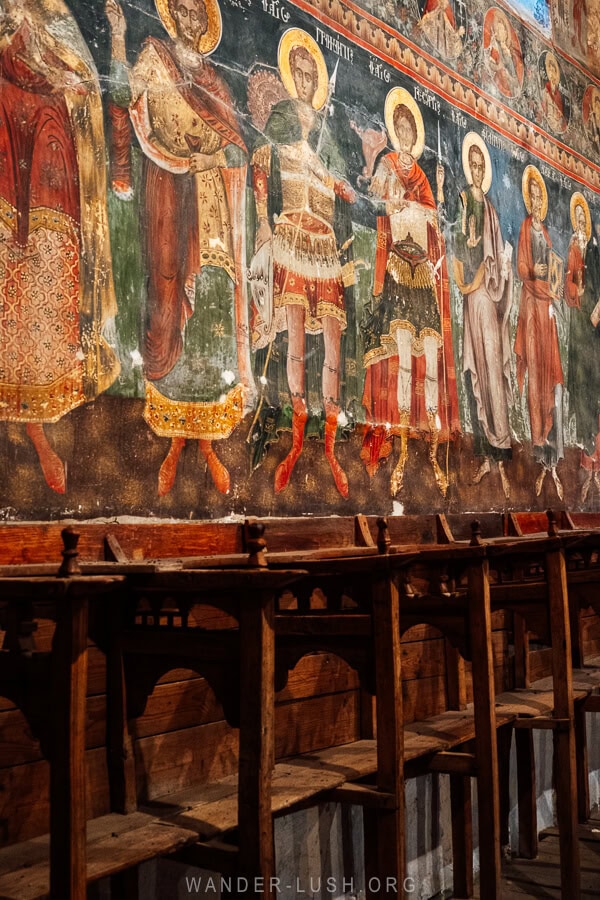
Our chaperone silently indicated that it was time to leave, and we slowly filed back out to the yard. I was the last to leave before he pulled the heavy wooden door shut with a thud. I watched him in slow motion, eager to soak up every last last dreg of the experience.
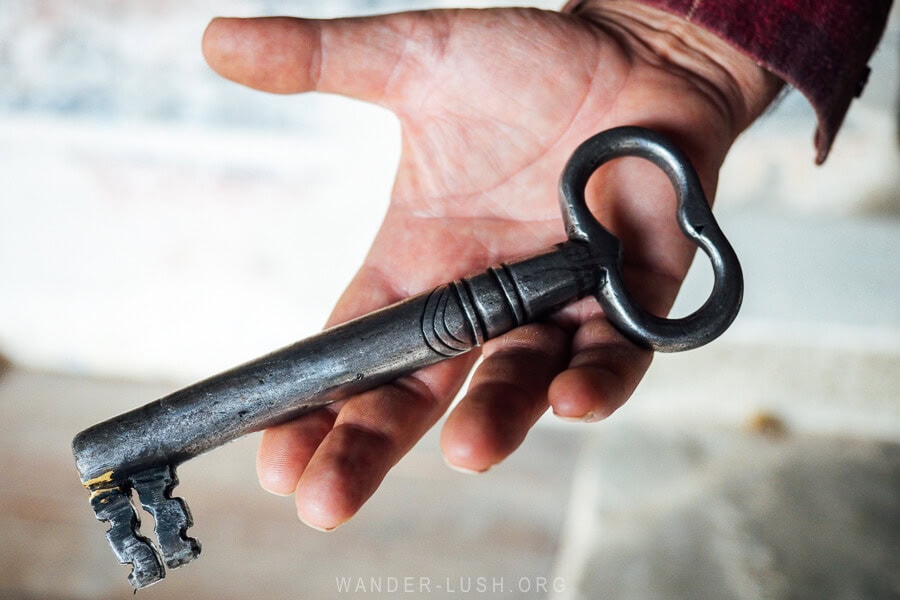
After snapping a photo of the giant key lying in the palm of his hand, we thanked him profusely and vowed to stay at his guesthouse on our next visit to Permet. I have every intention of keeping that promise.
Exploring Leus village
We left the church buzzing. I wasn’t quite sure what to do with myself. How do you digest an experience like that, what do you say, and where do you go next? I felt like I had to sit down to process it properly.
After the technicolour tones and dramatic lighting of the church, the outside world felt somehow muted. It was dusk by the time we made it back out into the village, and the soft colours of the foliage and late summer flowers felt like such a contrast to surreal environment we had just stepped out of.
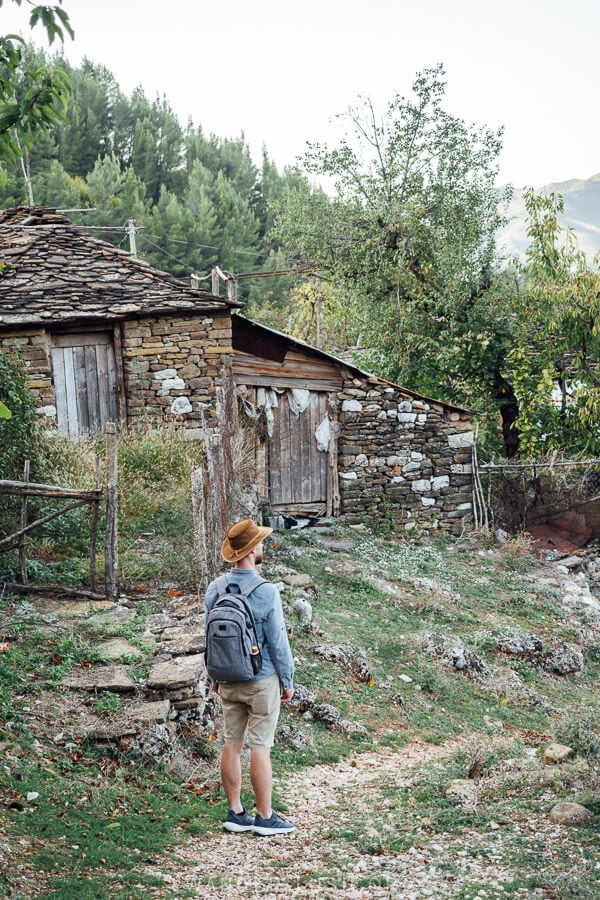
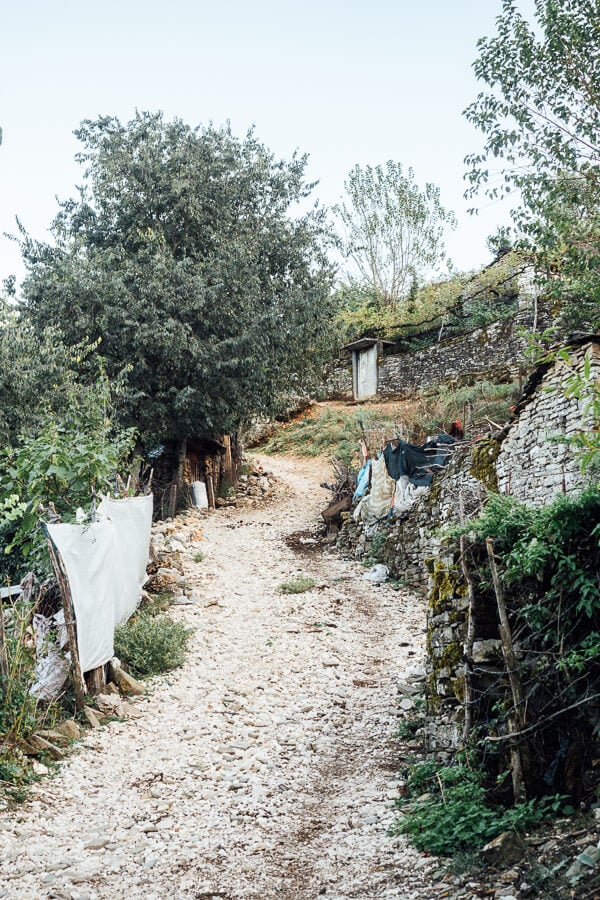
We decided to use the last hour or so of light to make our way around the village. With only a few ‘streets’ – actually pitched dirt paths with the occasional cobbled laneway – it didn’t take us long.
After winding a path between the little stone houses and garden sheds, we started our descent back into Permet.
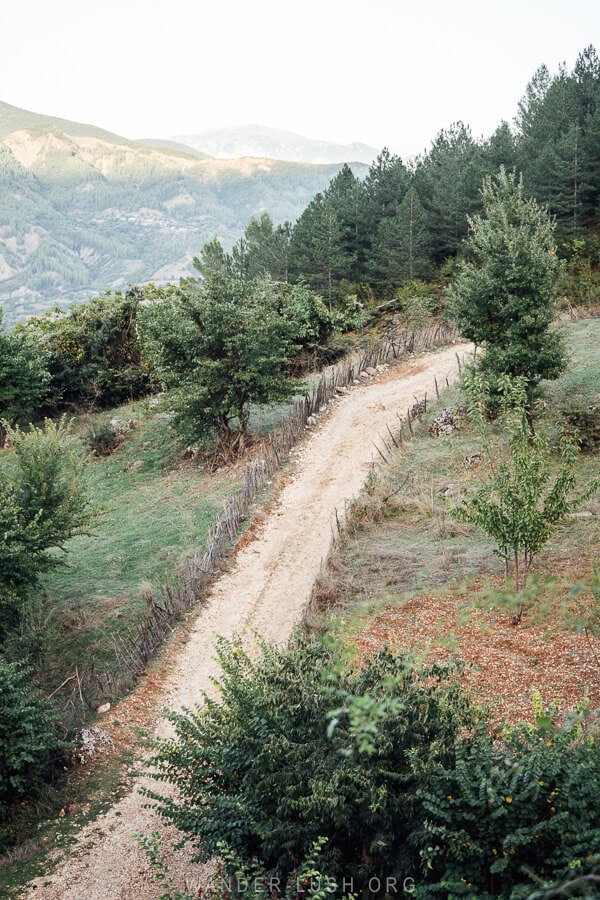

Practical tips for visiting the Church of Leus
- The easiest way to get to the Leus and the church from Permet is by foot, walking via the unpaved road as we did. If you prefer to go by car, taxis are available in Permet. A 4WD is essential.
- There are no official opening hours for the church. The key is available on request – if you know which gate to knock on… (Hint hint: It’s the blue one).
- I highly recommend spending a night in the village at Chri Chri Guest House. The owner has access to the church and can coordinate your visit.

More inspiration for Albania
- The ultimate Albania road trip itinerary, my top recommendations
- Things to do in Permet, beyond Leus Church
- Guide to Leskovik, including the Melesin Distillery
- Things to do in Korca, more churches!
- Guide to Lin, the best place to stay on the Albanian side of Lake Ohrid
- Things to do in Gjirokaster, the stone city
- Guide to Dhermi, my favourite village on the riviera
- Visiting Upper Qeparo, a semi-abandoned village
- The best of Berat, Albania’s UNESO castle city
- My guide to Tirana, Albania’s quirky capital
- Valbona National Park, hiking in the Albanian Alps
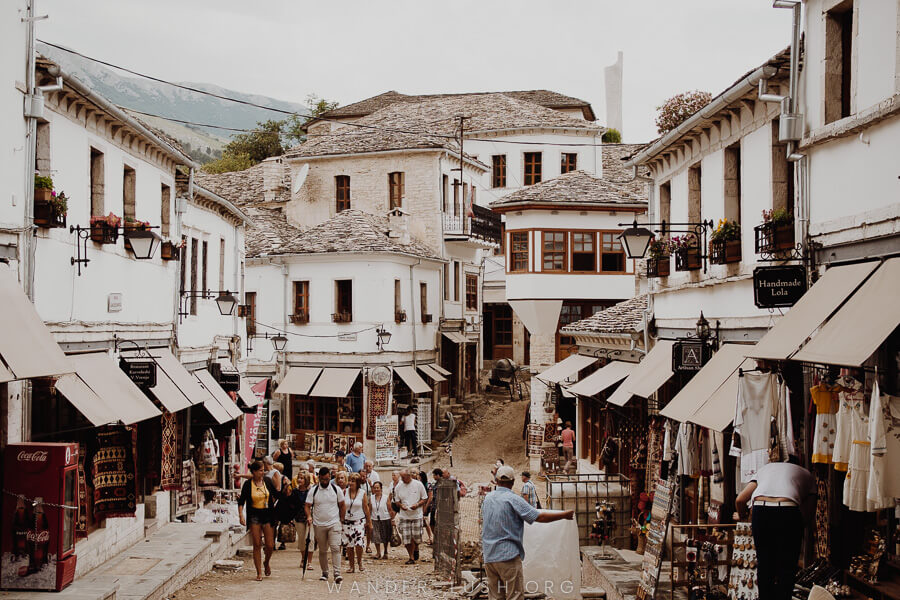
Albania Travel Guide
Discover insider tips, itinerary inspiration, and all the best things to see, do and experience in Albania!
Albania Essentials
My favourite resources and tools for planning a trip to Albania.
More from Albania
Albania Travel Guide
Discover insider tips, itinerary inspiration, and all the best things to see, do and experience in Albania!



